Interesting Lemon Shark Facts For Kids (2024 Updated)
Lemon sharks are a species of shark known for their striking yellow coloration and unique behaviors. They are typically found in shallow, coastal waters in tropical regions of the Atlantic and Pacific Oceans. Despite their intimidating appearance, lemon sharks are generally not considered to be a threat to humans and are known for their docile and inquisitive nature. In this way, lemon sharks serve as a fascinating and important component of marine ecosystems, playing a vital role in maintaining the delicate balance of oceanic biodiversity.
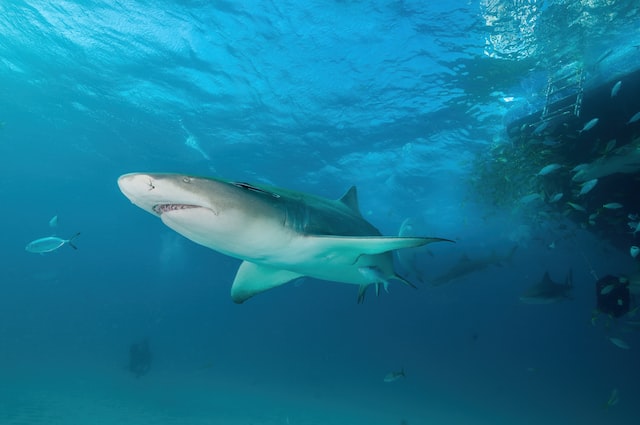
Basic Lemon Shark Facts
Name
The scientific name for the Lemon shark is Negaprion brevirostris.
Scientific Classification
The Lemon Shark’s scientific classification is as follows:
- Kingdom: Animalia
- Phylum: Chordata
- Class: Chondrichthyes
- Order: Carcharhiniformes
- Family: Carcharhinidae
- Genus: Negaprion
- Species: Negaprion brevirostris
Latin Name
The Latin name for Lemon Shark is Negaprion brevirostris.
Appearance (physical characteristics)
Lemon sharks have a pointed snout and a broad head with a yellow-brown coloration. They have triangular and serrated teeth for catching and consuming their prey. With their large, dark eyes, they are well-equipped to hunt and navigate their environment. Adults can grow up to 8-10 feet long and weigh up to 500 pounds.
Size and Weight
Lemon sharks can reach an average size of 8-10 feet (2.4-3 meters) in length and weigh up to 500 pounds (227 kg) at maturity. However, some individuals have been known to grow larger than this, with the largest lemon shark ever recorded measuring over 11 feet (3.4 meters) in length. Juvenile lemon sharks are much smaller, typically measuring around 2-3 feet (0.6-0.9 meters) in length when they are born.
Habitat and Range
Lemon sharks are found in the warm, shallow coastal waters of the Atlantic and Pacific Oceans. They prefer nearshore habitats near coral reefs and mangroves, but can also adapt to brackish and freshwater environments. They typically grow up to 8-10 feet in length and weigh up to 500 pounds.
Diet
Lemon sharks are opportunistic predators that feed on a diverse range of prey, including bony fishes, crustaceans, and cephalopods. They hunt using their excellent sense of smell and electroreception and are skilled ambush predators. Lemon sharks play an important role in maintaining a balance among the various species they feed on.
Life Expectancy
Lemon sharks can live up to 27 years in captivity and have a lengthy lifespan. Their lifespan in the wild is not well documented but is influenced by various factors such as genetics, environmental conditions, and human impact. Juvenile lemon sharks are more vulnerable to threats, while adult lemon sharks have fewer natural predators but may face human-related risks such as fishing and habitat loss.
Fun facts about Lemon Sharks
1. Multilingual Naming of the Lemon Shark and Its Camouflaging Abilities
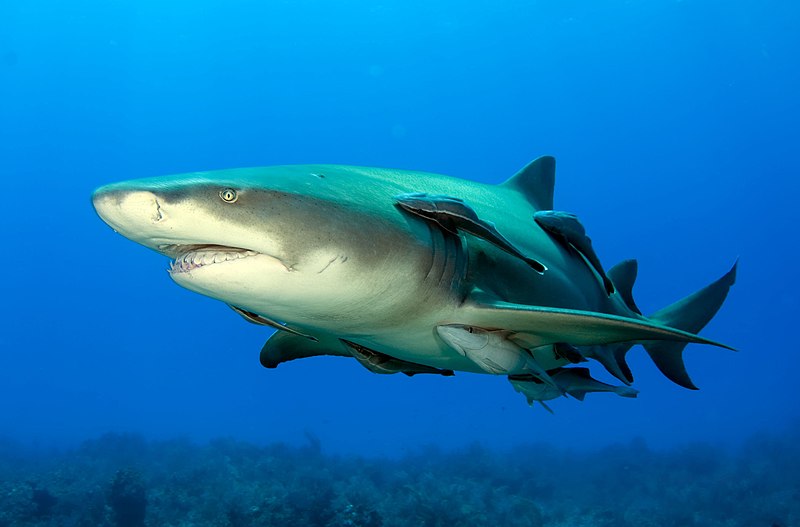
The lemon shark is named for its skin and has different names in different languages. In German, it is called “zitronenhai” and “kurznasenhai,” while in Spanish, it is known as “tiburon galano.” Its distinctive skin coloration helps it camouflage on the sandy seafloor, enabling it to surprise its prey.
2. Lemon Shark Habitat: A Diverse Range and Its Proximity to Humans
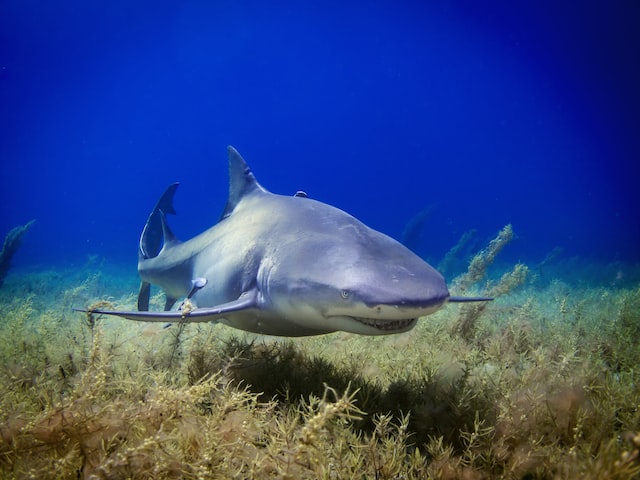
Lemon sharks are subtropical coastal dwellers, but can also venture into open ocean waters up to 300 ft (92 m) deep. They primarily live in coral reefs, mangroves, and river mouths, and can tolerate brackish water. However, they cannot stay buoyant in freshwater for long periods. Lemon sharks are commonly found near tourist beaches due to their habitat preferences.
3. Adaptive Vision of Lemon Sharks for Murky Waters
Due to their habitat, Lemon Sharks have adapted with unique eyes to help them see, although they have poor eyesight. They rely mostly on electroreceptive to navigate and hunt prey. Their eyes contain both rods and cones, similar to humans, and have a special retina that reduces glare and enhances their vision in the yellow-green light spectrum.
4. Lemon Sharks: Nocturnal and Selective Predators with Unique Hunting Techniques
Lemon Sharks are choosy nocturnal predators that prefer slow-moving prey like parrotfish, mojarras, and crustaceans. They use electroreceptors to detect prey and stalk them until the right moment to attack. Unlike other sharks, Lemon Sharks bite their prey and shake their head from side to side until they tear flesh.
5. The Social Complexity of Lemon Sharks: Insights into Their Group Dynamics and Intelligence
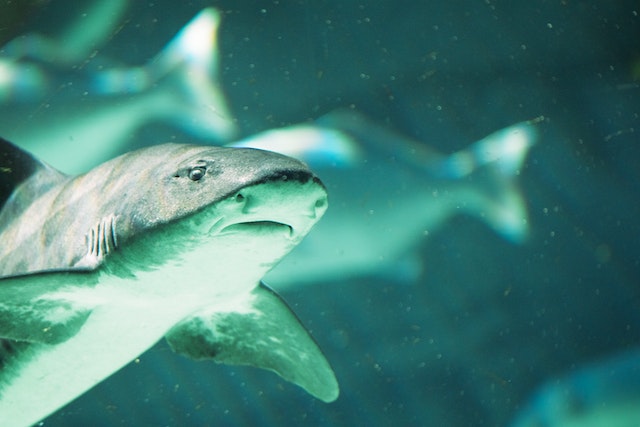
Lemon Sharks are social animals that form groups with similar-sized sharks. Younger Lemon Sharks group with larger sharks for protection. Their groups have complex social rules, dominance hierarchies, and high levels of cooperation. Lemon Shark groups communicate about prey, hunting strategies, and hunting territories in a manner akin to wolf packs. Their large brains contribute to this social complexity.
6. Lemon Sharks: Surprisingly Tolerant of Captivity for Intensive Study and Conservation
Unlike other shark species, Lemon Sharks can thrive in captivity due to their tolerance for enclosed spaces. This makes them a popular choice for aquariums and zoos, allowing for in-depth research and conservation efforts. Though they are ideally suited to the wild, captivity offers a unique opportunity to study this fascinating species.
7. Gentle Giants of the Sea and Endangered Species
Although lemon sharks are fierce predators in the ocean, they are not a significant threat to humans. There have only been 10 confirmed instances of lemon sharks biting people, and none of them have resulted in death. Despite their peaceful nature towards humans, Lemon Sharks are endangered due to overfishing for their meat and leather.
8. The Complex Mating Rituals of Lemon Sharks”
Lemon Sharks, being intelligent and social, have complex mating rituals that involve various behaviors such as dominance displays and selective biting. They reproduce every two years in mangroves and use their electroreceptors to find potential mates. Females mate with multiple partners and paternity is determined by sperm competition in the womb.
9. The Feeding Habits of Lemon Sharks
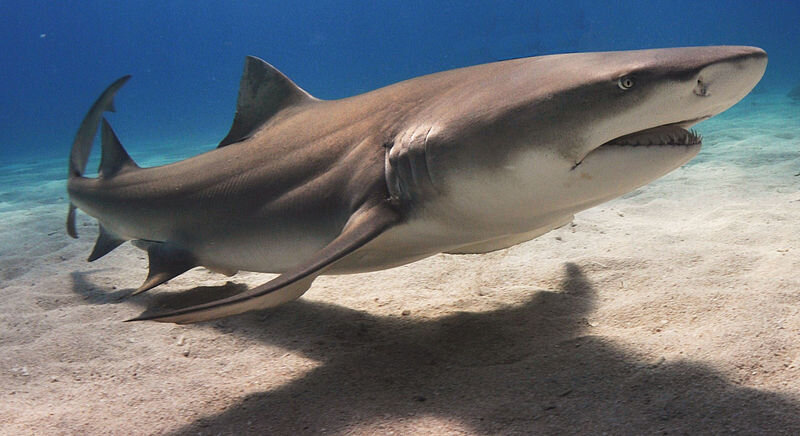
When Lemon Sharks see the movement of a sizable school of prey in the water, they engage in what is known as “feeding frenzy” behavior. This is a coordinated, directed group assault where several sharks will attack the prey simultaneously, overwhelming and disabling it. Scientists have observed this behavior in many shark species, and it is thought to be a way to maximize their chances of catching prey, which may otherwise be difficult to catch as individuals. Lemon Sharks will also scavenge together, sharing any found carrion. This behavior is thought to be a way for the sharks to cooperate and increase their chances of survival, as they can find and consume food more efficiently as a group.
10. The Role of Father Lemon Sharks in Parenting After Birth
Lemon sharks have a distinct parenting approach where the mother primarily takes care of the young, but the father also helps after birth. While the mother is the main caregiver, the father supports the upbringing of the offspring by protecting them from predators and teaching them some survival skills.
11. The Solitary Lifestyle of Lemon Sharks
Lemon sharks are known for their solitary behavior, which sets them apart from many other shark species. Unlike social sharks such as blacktip reef sharks or nurse sharks, lemon sharks tend to move and live alone. They may occasionally be observed in pairs or small groups, but these instances are rare and often occur during mating or feeding periods.
Conclusion
In conclusion, lemon sharks are a fascinating species of shark that exhibit unique behaviors and characteristics. From their solitary lifestyle to their parental care, lemon sharks have evolved to thrive in their oceanic environment. Although they may be encountered by humans during snorkeling or diving excursions, it is important to treat these sharks with respect and caution to ensure the safety of both the sharks and the people who encounter them. By learning more about these amazing creatures and taking steps to protect their habitats, we can help to ensure the continued survival of lemon sharks and other shark species for generations to come.
